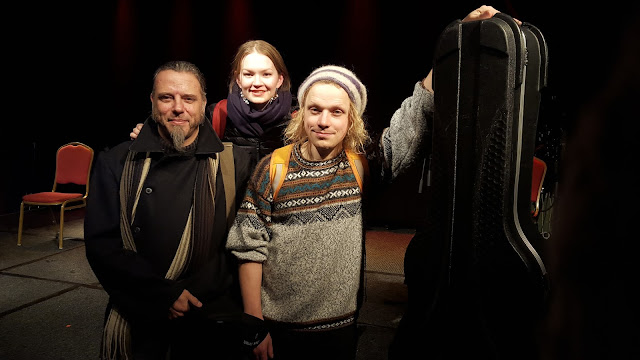Anarchist militants from Brazil, Spain, Argentina and Uruguay fly an Argentine Auca - Socialismo Libertario (Auca-SL) flag on top of a tank, Porto Alegre, Brazil.The photograph was shot at a military museum - but anticipates a future victory of the popular classes over the militarised Brazilian elites © Michael Schmidt 2003
Cart-driving catadores and members of Brazilian (FAG and others), Mexican (CIPO-RFM), Argentine (Auca-SL) and South African (BMC) anarchist organisations have a dinner together, Gravataí, Brazil © Michael Schmidt 2003
Posing outside their headquarters, militants of the Associação dos Carroceiros e Catadores of Gravataí, Brazil.There are numerous similarities between Brazil and South Africa in terms of both having emerged from autocracies into "democracies" run by neo-liberal "socialist" parties that waged a war on the black-majority poor © Michael Schmidt 2003
Federação Anarquista Gaúcha (FAG) members introduce Federación Anarquista Uruguaya (FAU) militant Juan Carlos Mechoso, centre, at Jornadas Anarquistas, Porto Alegre, Brazil. Mechoso is a veteran and historian of the powerful 500-member post-war Uruguayan FAU which helped found a 400,000-strong Convención Nacional de Trabajadores (CNT) union federation, a 10,000-strong Resistencia Obrero Estudantil (ROE), and which had its own armed wing, Organización Popular Revolucionaria-33 Orientales (OPR-33) which fought against the neo-fascist Bordaberry Dictatorship © Michael Schmidt 2003
The full-house audience at Jornadas Anarquistas, Porto Alegre, Brazil © Michael Schmidt 2003
Two daring youths fly Palestinian flags from atop columns during the World Social Forum, Porto Alegre, Brazil © Michael Schmidt 2003
Michael Schmidt of the Bikisha Media Collective (BMC), South Africa, addressing the inaugural Encuentro Latino Americano de Organizaciones Populares Autónomas (ELAOPA), an autonomous grassroots movement still active today, on the radical grassroots social movements in South Africa, Porto Alegre, Brazil. FAG member Bruno Rocha (black shirt) kindly provided translation © Michael Schmidt 2003
In a room hung with Resistência Popular flags, part of the ELAOPA audience at Porto Alegre, Brazil © Michael Schmidt 2003
Raul Gática (black shirt) of the Consejo Indigena Popular de Oaxaca - “Ricardo Flores Magon” (CIPO-RFM) of Mexico who was shortly to be forced into exile in Canada by death-squads operating in Oaxaca © Michael Schmidt 2003
Leny Olivera, centre, and her Bolivian cultural resistance group Tinku Juvenil performing at ELAOPA, Porto Alegre, Brazil. She told me police had killed 15 of her friends in struggles between autonomous communities and the state-capitalist combine over control of Bolivia's natural resources - but said she remained unafraid © Michael Schmidt 2003
[ENDS]




































